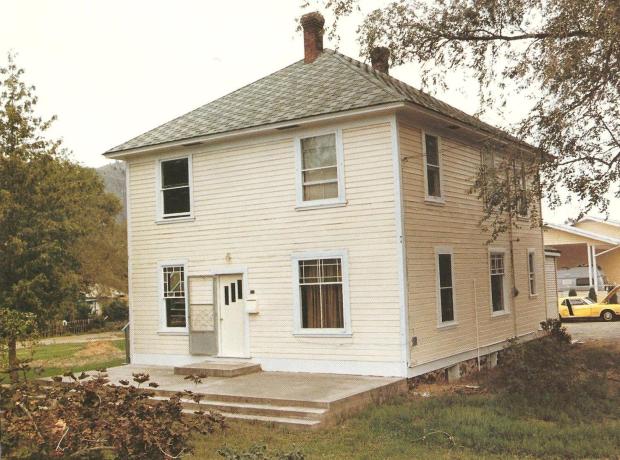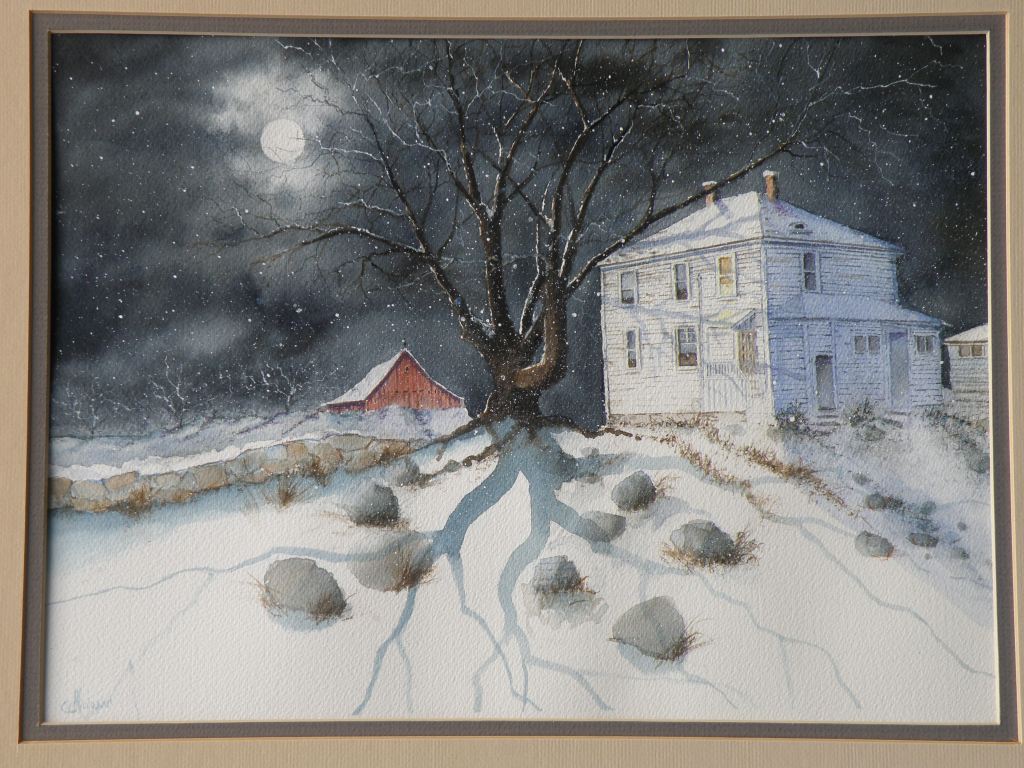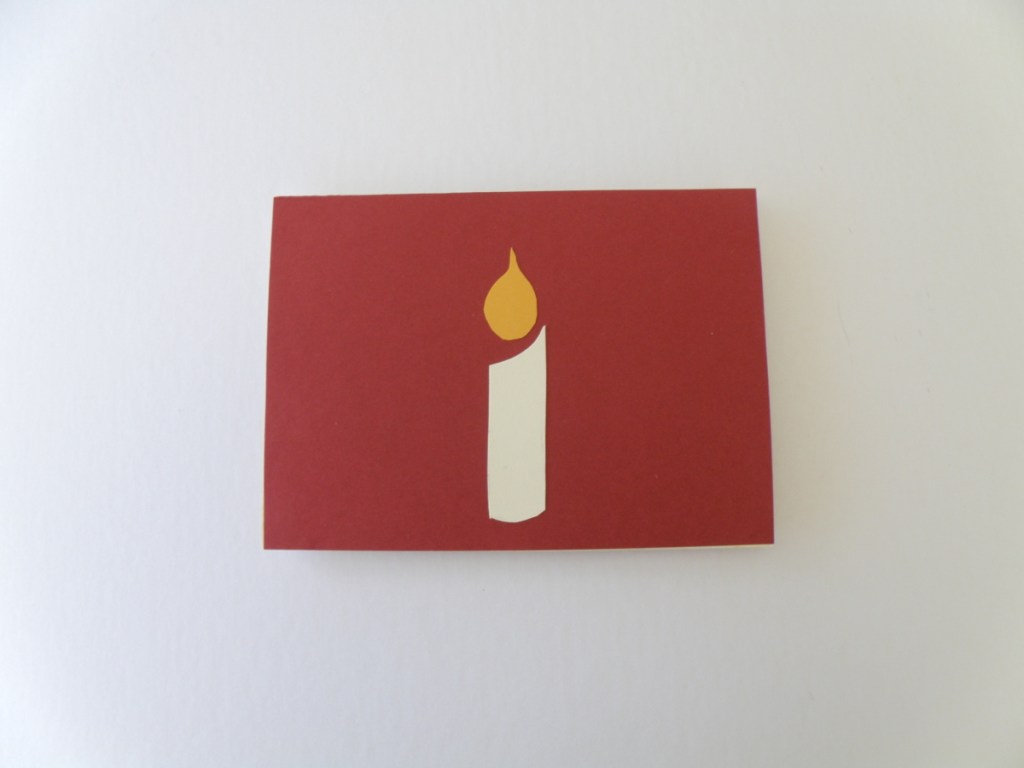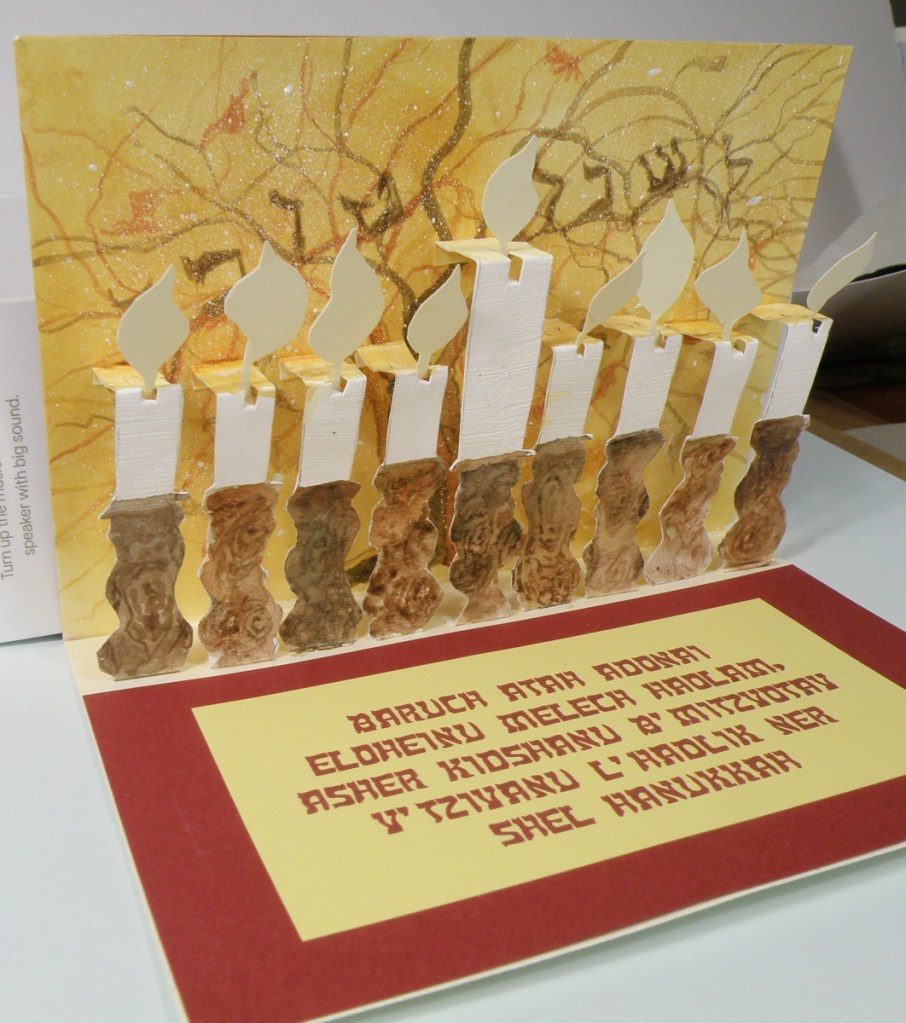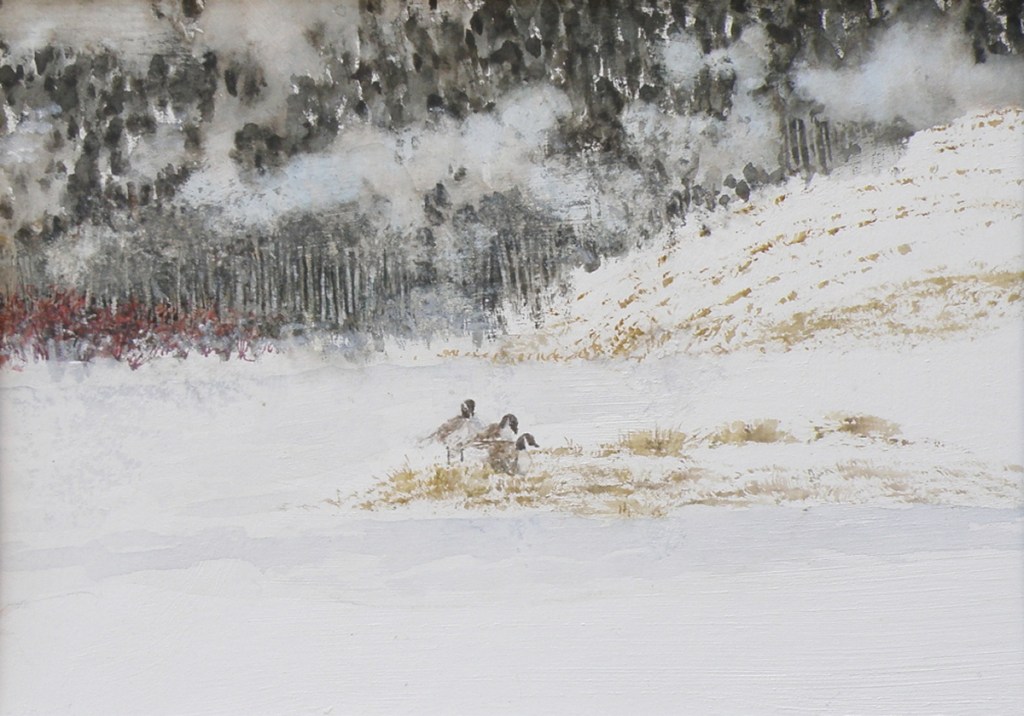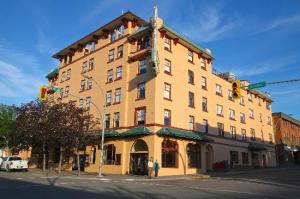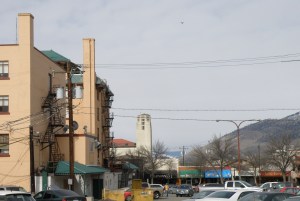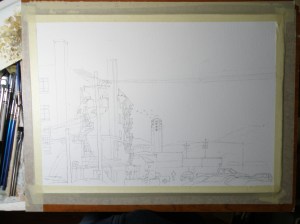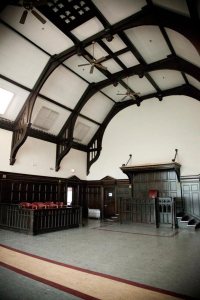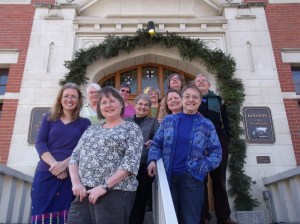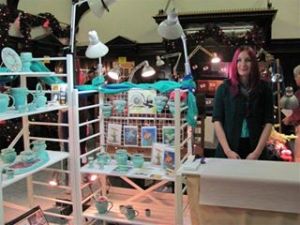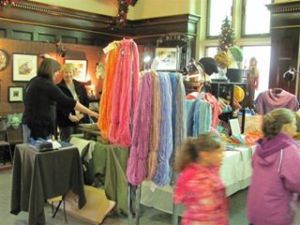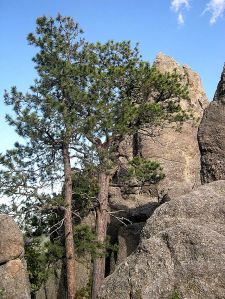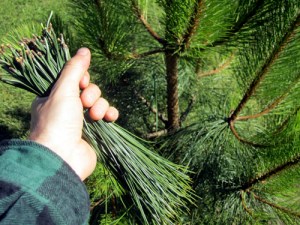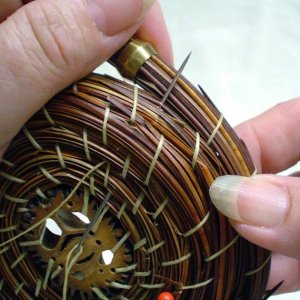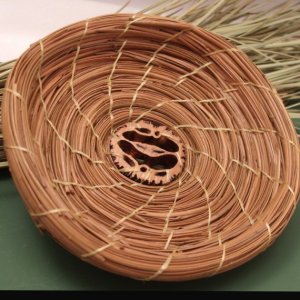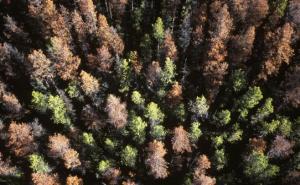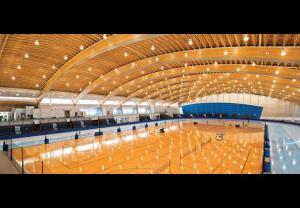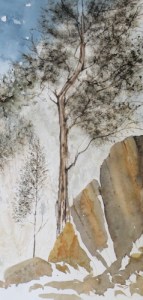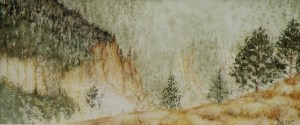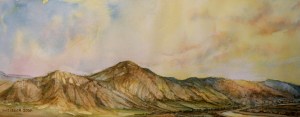Winter Watercolours
January 5, 2022
One of Kamloops’ older homes, the Fort House at the corner of Fortune Drive and Fort Avenue, is so named because it is on land formerly part of The Hudson Bay Company’s fur-trading post.
“. . . According to a listing of heritage buildings published by the Kamloops Museum and Archives years ago, the fur-trading post was located there from 1843 to 1862, at which point the Hudson’s Bay Company moved its post to Mission Flats.

However, the company continued to use the land for agriculture until B.C. Fruitlands bought it in 1906 and subdivided it into lots of five or so acres.
The Fort House was built about 1907 for Archie Davis, a railway employee. ‘The house, a foursquare design with a cottage roof common for that period, was originally located on extensive acreage’. . . ” [source: https://armchairmayor.ca/2014/05/24/answer-man-reader-wants-to-know-the-story-behind-the-old-fort-house-on-fortune-drive/#prettyPhoto%5D
! חג אורים שמח
November 29, 2021
‘Chag Urim Samaech!’ translates as ‘Happy Festival of Lights’ and proclaims with Jews everywhere the eight day remembrance of a miracle, when, in 165 BCE, in a period of dark unrest, at the rededication of the 2nd Temple, “. . . though there was only enough untainted olive oil to keep the Temple menorah’s candles burning for a single day, the flames continued flickering for eight nights, leaving them time to find a fresh supply. This wondrous event inspired the Jewish sages to proclaim a yearly eight-day festival. . . “
It is worth noting that Hanukkah is considered one of the lesser celebrations in the Jewish year with Passover (Pasach), The Day of Atonement (Yom Kippur) and Rosh Hashanah far greater in significance. But likely due to the overwhelming global attention lavished on Christmas, Jewish children have come to expect their own share of holiday fun and presents, especially when both celebrations (usually) happen in December. And so many Jewish households enjoy parties with latkes and jelly donuts, games like dreidel and the giving of presents on each of the eight days during which a new candle is lit on the menorah and prayers and songs are sung. Because December is the darkest of months, lighting these candles in a darkened room takes on a mystical quality, bringing warmth and glowing wonder to a cold and dismal time of year, while also joining celebrants with their ancestors from long ago.
In honour of Hanukkah, and because here in Kamloops, B.C., there isn’t a Hanukkah card anywhere to be found, I’ve designed and made a pop-up card for my former mother-in-law:

A Happy and Blessed Hanukkah to our Jewish friends, colleagues and neighbours here and around the world!
Painting Progression 4: Juno, finished
March 9, 2021
While painting this portrait of Juno in honour of Kathie’s birthday, our little Bichon, ‘Elmo’, was in the final days of his thirteen-year-old life. Stoically dealing with a heart twice its normal size, an enlarged liver and kidney malfunction, our beloved ‘Elmo’ passed away in his bed just after I’d checked on him on January 24th. For his two daddies, this was a sorrowful occasion and one very difficult to get over.
As the weeks passed, however, we realised we needed to at least try to fill the emotional hole of losing our lovely pet and began searching far and wide for a new puppy. At the same time, I was close to finishing the portrait of Juno and finally did, a couple of weeks before Kathie’s big day:
Kathie and Ken were very pleased and the Juno portrait now hangs in their dining room.
And we–Raul and I–have a new addition to our family, a tiny toy Maltipoo puppy named ‘Ashton’, who can never replace ‘Elmo’ and yet has won us completely over by his beautiful perky cuteness and charming personality:
when micro = macro
January 12, 2021

The largest bird on earth is–no surprise here–the Ostrich. Only the Emu comes anywhere close, and in N. America, our experience of the bird world (aside from some water birds and raptors) is most often an encounter with a species that is generally quite small. (Of course, after writing such a declarative sentence my mind’s eye gets filled with Ravens, Magpies, Embden Geese, Roosters and Pileated Woodpeckers, lol.)
Songbirds in particular are relatively tiny, thus lending themselves well to tiny portraits, which, when I was still a member of a Gallery, sold quite steadily and well.
Try A Little Tenderness
January 1, 2021
Daring to re-write Otis Reading’s hit song for this brand spanking New Year:
“A word soft and gentle makes life easier to bear,
You won’t regret it, people won’t forget it–for love is our whole happiness
And it is all so easy. Try a little tenderness.”
Wishing you a more tender, gentle, and forgiving 2021.
Summer’s Zenith
August 5, 2020
We’ve been sizzling here in British Columbia’s Southern Interior. For the past two weeks, it has been very hot and very dry. This is when all the dirt bikes get loaded on the back of country music-blaring pickups, heading for the hills, bypassing all the slower, fishing boat-toting pickups. And even those pickups bypass the even slower camper trailer-toting pickups, with everyone and their dog all heading out of Dodge.
What’s left behind are solitary scenes of empty pasture, sun-weathered farms, the occasional horse. And not a lick of shade.

We’re at the apex of Summer–the zenith–with a high today of 35C (95F). And tomorrow? Well, tomorrow marks the slow slide into September, with showers and a high of only 23C (73F).
So today we pretend we’re Texans, and tomorrow that old familiar tinge of an early Fall brings us all back to where we really are and love to be.
The Returning of Hot Days
July 25, 2020
I live with my husband, Raul, on a residential street that backs onto a mountain ridge which eventually meets up with the Lac du Bois Grasslands protected area . About half of our backyard is the sage and tumble weeded rise itself, and below it a manmade terraced section for growing our vegetables. Coyotes yip erratic bark-like shrieking at 2am, while morning Mule Deer come down to nosh on Raul’s tomatoes. Families of Chukar Partridges venture down as well, their clucking and chukking exploding into a fearful feathery cloud when surprised.
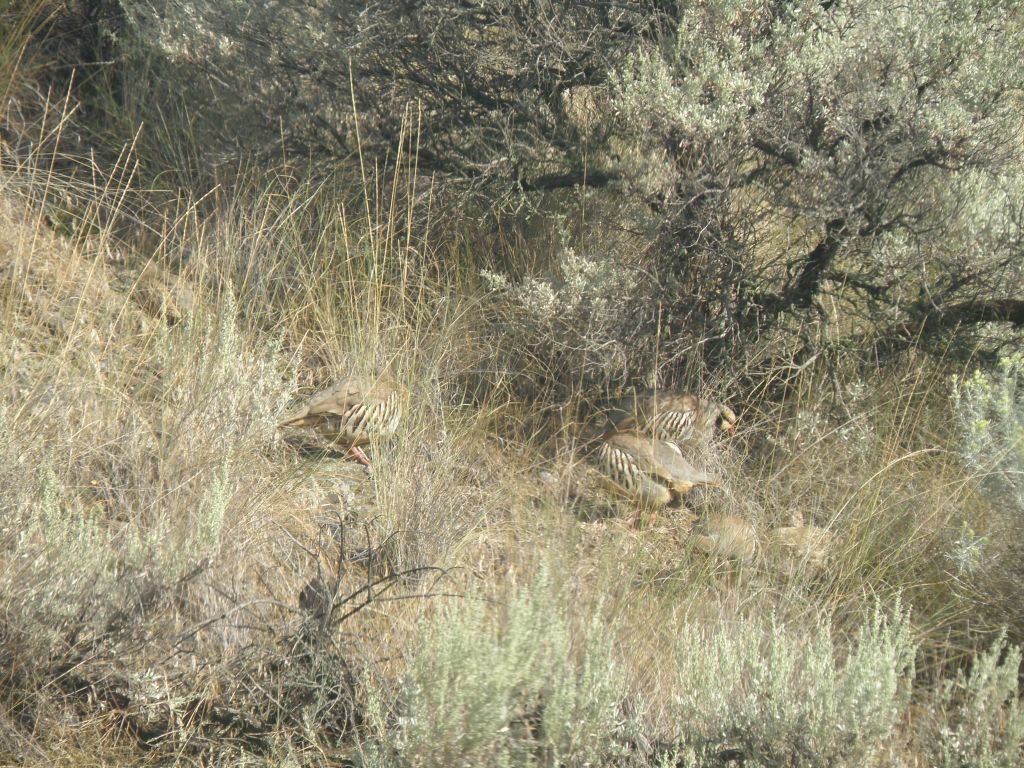
But the deer? If their brunching is interrupted, they continue sampling tomatoes, dropping one to nibble another and dropping it for then another, slightly raising their heads as though eyeing the intrusive buffet busboy, checking to see if I’m there to replenish the salads. And only when physically confronted by threatening rudenesses will they disdainfully bound up the slope, staring down just beyond reach, waiting for the vulgar help to leave so they can have a little chat with the maitre d’.
Kamloops, British Columbia, (“Kamloops” is the anglicized version of the Shuswap word “Tk’əmlúps“, meaning “meeting of the waters”–the North and South Thompson join to become the Thompson River) officially has the hottest and driest summers in Canada, with the hottest recorded temperature of 41.7C (107F), with the coldest being -38.3C (-37F). The humidity is almost always between 20-40%, and so is designated as part of the desert region extending up through the interiors of Oregon and Washington States.

This week promises to be our first of the season hot weather, with temperatures in the mid to high 30s (93 – 97F). Up until now, we’ve had unseasonably wet and moderate days, with almost zero instances of wildfire, our greatest seasonal hazzard.
Peace
April 12, 2020
A bouquet of Peace roses on Easter Sunday, offering up peace of heart and mind during these uncertain times of isolation ….

watercolour, 7.5″ x 10″, Arches #140 Cold Press Paper
by Lance Weisser
SOLD
The Peace Rose was developed/cultivated from a seed the size of a pinhead in Lyon in 1935 by the French commercial rose-growing family, the Meilland’s, and introduced simply as ‘3-35-40’. Attracting much attention for its beauty at a rose convention in 1939, France was invaded by Hitler and the Meilland properties seized and used for food production.
In desperation, the Meilland’s smuggled ‘3-35-40’ out of France in a diplomatic satchel to The United States, where, in 1940, it was submitted to The All-America Rose Selections (AARS) for a three year testing. Based on the success of this testing, a launch date of April 29, 1945, was chosen to coincide with the Pacific Rose Society Annual Exhibition in Pasadena, California.
‘3-35-40’ still did not have a real name. Then, April 29th, 1945, its official launch date, coincided with the fall of Berlin and the declaration of a Europe-wide truce.
At The Pacific Rose Society Annual Exhibition, two doves were released and ‘3-35-40’ was christened by The AARS via this statement:
“We are persuaded that this greatest new rose of our time should be named for the world’s greatest desire: ‘PEACE’.“
The new rose ‘PEACE’ was officially awarded the AARS award on the day that the war in Japan ended, and on May 8, 1945, with the formal surrender of Germany, each of the 49 delegates to the newly created United Nations were presented with a bloom of “Peace”.
“As for the Meillands, whose rose farms and family assets were destroyed by World War II, the commercial success of “Peace” enable the family business to recover and subsequently continue to develop new, beautiful roses. In what might be a moral to a parable Francis Meilland, who died in 1958, wrote in his diary:
‘How strange to think that all these millions of rose bushes sprang from one tiny seed no bigger than the head of a pin, a seed which we might so easily have overlooked, or neglected in a moment of inattention’ . . . “
Grass-fed and rather contented….
March 21, 2020
Although centrally located–and well within the city limits of Kamloops (pop: 97,000), British Columbia, Canada–we nonetheless hear cows bellowing distantly from the mountain range across the way from our house. This is cow country–beef cows–Herefords–grass-fed, and let out to pasture once Winter is past. Sitting out on our deck, I can just make out these tiny dots–Herefords most certainly–moving slowly across the great expanse of what is locally known as Strawberry Hill.
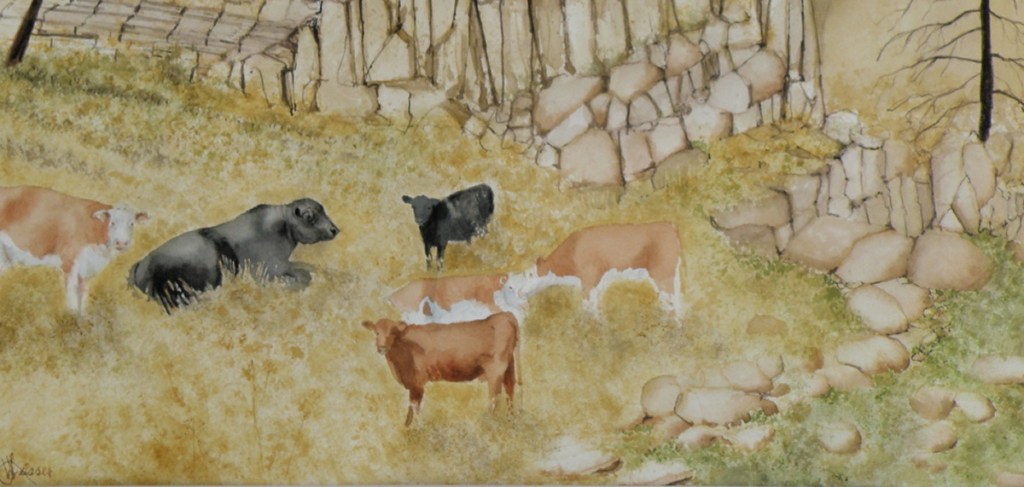
watercolour (detail of larger work), Arches Cold Press 140# Paper, 7.5″ x 14″
by Lance Weisser
During these unusual and routine-disrupted days, when everyone seems mildly ajar, pretending all is still fine, yet wondering what the heck to do with themselves, I find it reassuring to watch cows do nothing all day but search out grass on Strawberry Hill.
(And I’m sure many of you reading this have become even more thankful you have pursued painting or photography or writing as a mainstay in your life. These solitary-type endeavours are certainly now helping to anchor us amidst days of remarkable change and confinement.)
Small Works Show 2019
January 10, 2020
Our Kamloops Arts Centre in Kamloops, B. C., does our city of 100,000 proud by hosting and promoting many art events throughout the year. The 2019 Small Works Show is a fundraising event whereby half of all art purchases go to the KAC, and the remaining half goes to the artists.

“Venetian Memories” is one of my entries featured in a local store window. Below, the rest of my contribution is on a wall in the hallway of The Old Courthouse.
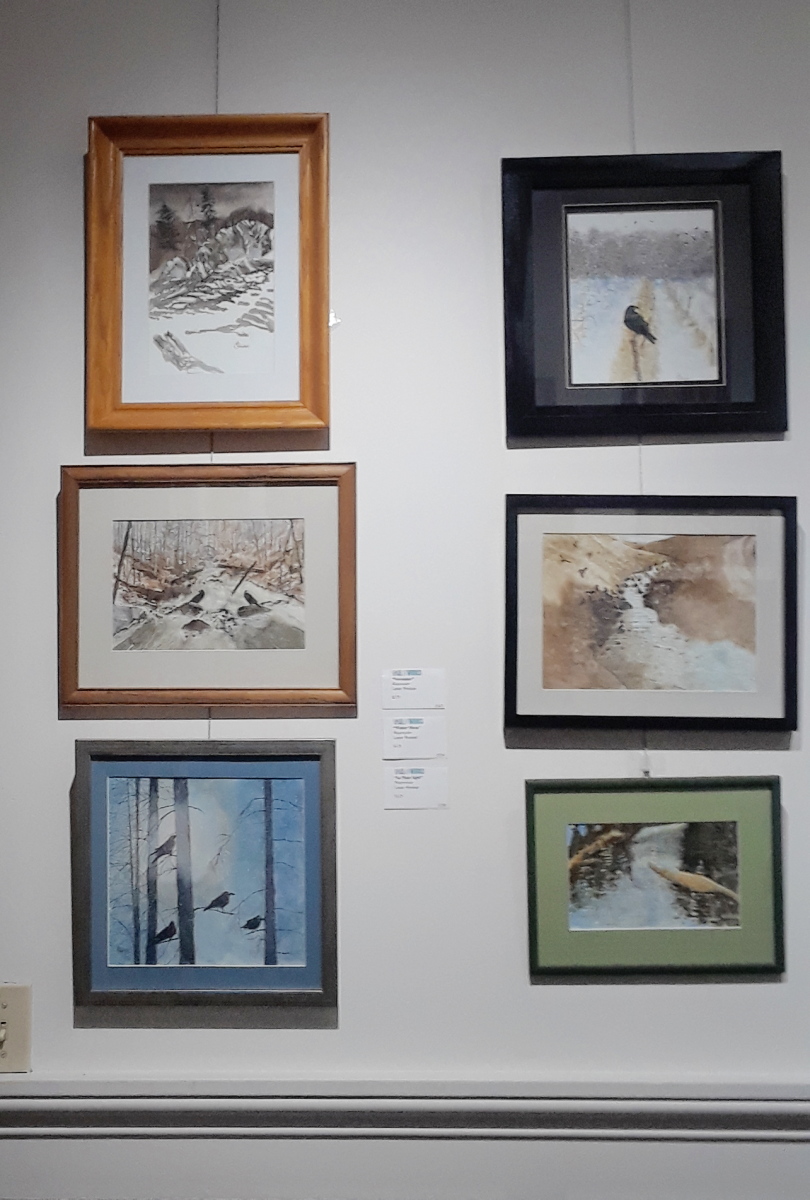
Our Kind of Winter
December 3, 2019
Having lived nearly 20 years in Vancouver and Victoria, B. C., Canada, where snow is a novelty and rain is the norm, it is a delight to then have restored the four definite, uniquely-blessed Seasons which we have here in Kamloops, B. C.
I’m a winter and cold month lover. Let me count the reasons: sweaters; hot spiced drinks; hearty stews and bread; cold room/many blankets; blue snow at dusk; birds at the feeders; bare-branched trees; lights under snowy pine boughs; woodpeckers at suet blocks; snowdrift patterns; long purple shadows; pre-dawn owl hoots; snow-muffled dog barks; pink-cheeked kids with sleds; fired-up logs; the music of the Season.
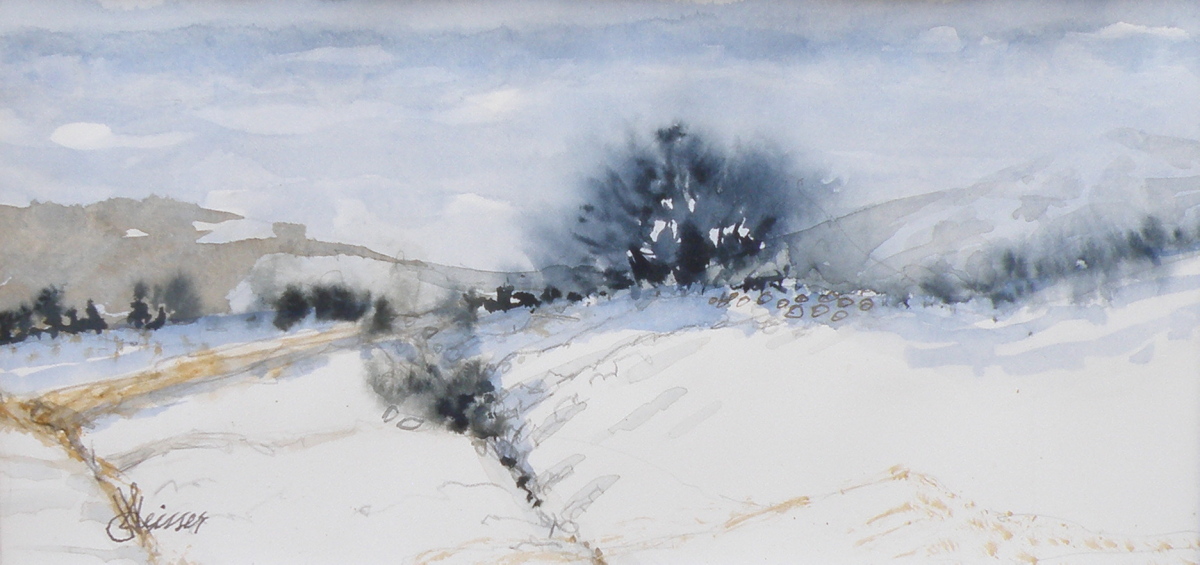
watercolour by Lance Weisser
Arches Hot Press 140# Paper; 5″ x 9″
….cedar waxwing
April 23, 2016
As a kid, having to enter the annual Science Fairs in Jr. High–the ones where invited experts walked around with clipboards trying to find possible prize winners–I had exhibits which were often concerned with birds–songbirds, usually–their migration patterns and predators, and fun facts.
I never won a prize. That usually went to kids who electrocuted themselves voluntarily in order to prove water and wires don’t mix–or the kids who cross fertilized seeds and created vegetative freaks.
The shortlist I had then in the 50s (living in upper New York State) was to see any kind of Bunting (they looked outrageously colourful), our State Bird the American Bluebird (which I never did see, and still haven’t), any kind of Tanager, and of course, any kind of Waxwing.
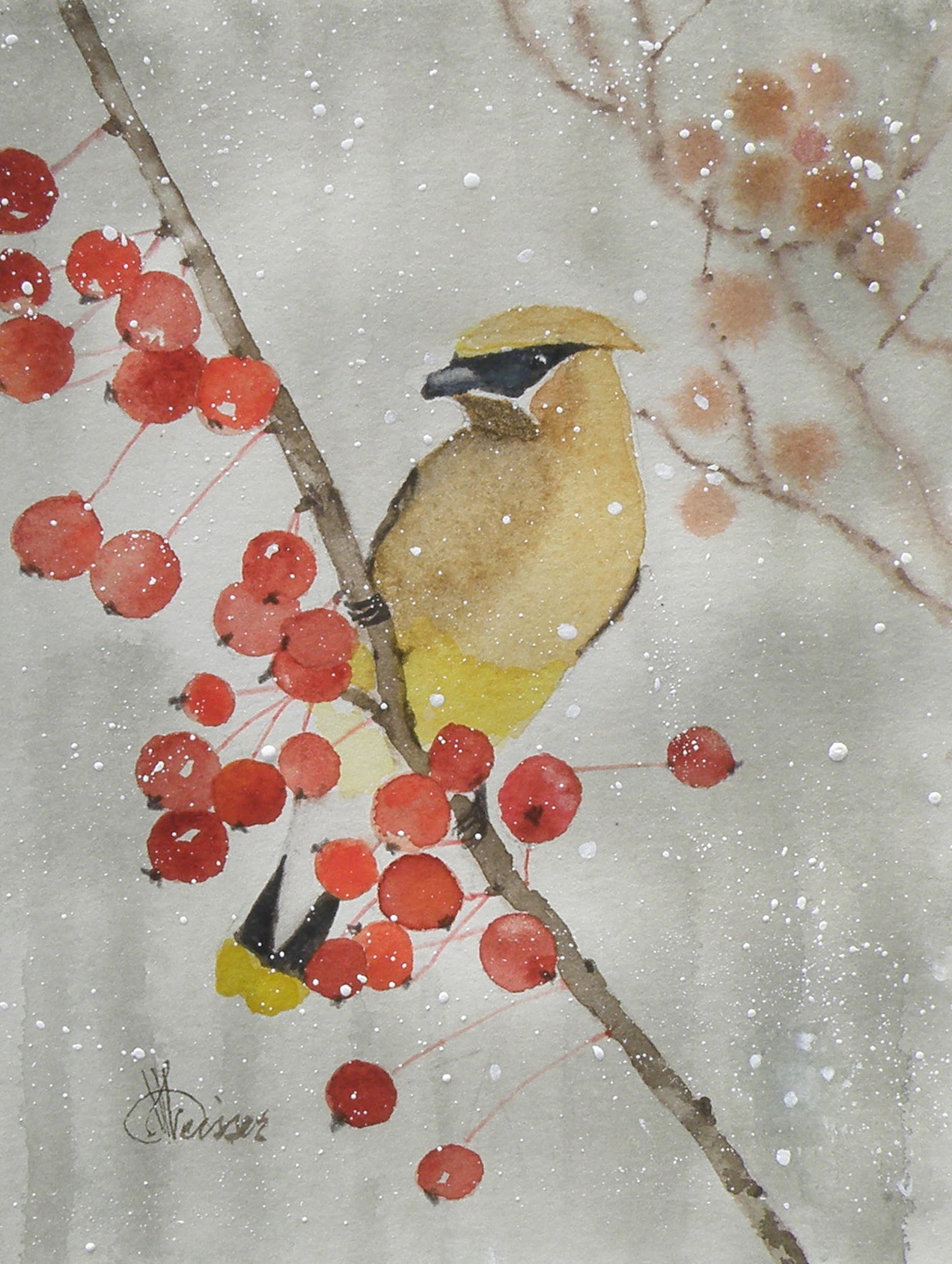
“Berry Picking”
Cedar Waxwing, 4″ x 6″, watercolour, Saunders Waterford Hot Press 140# Paper
Having lived now in seven different Canadian locations, from coast to coast, I’ve been able to photograph a Western Tanager in our front garden, a pair of Mountain Bluebirds (astonishingly blue), and a group of Cedar Waxwings which descended on our Red Maple branches and began dismantling a Robin’s nest, rather than having to bother scavenging their own material.
The Waxwings were much smaller than expected, and every bit as fascinating as I’d hoped. Their ‘bandit’s mask’ gives them an allure other birds lack, and their interesting ‘song’ and penchant for travelling about in flocks makes them worth having to wait 60 years to see them.
…..Keeping Watch
April 7, 2016
Our little Gallery in the small city of Kamloops, B. C.’s historic Courthouse (1911) has a Featured Artist offering every month and May will be my month to put on a display of recent miniatures. So now it is a matter of working towards having a good showing.
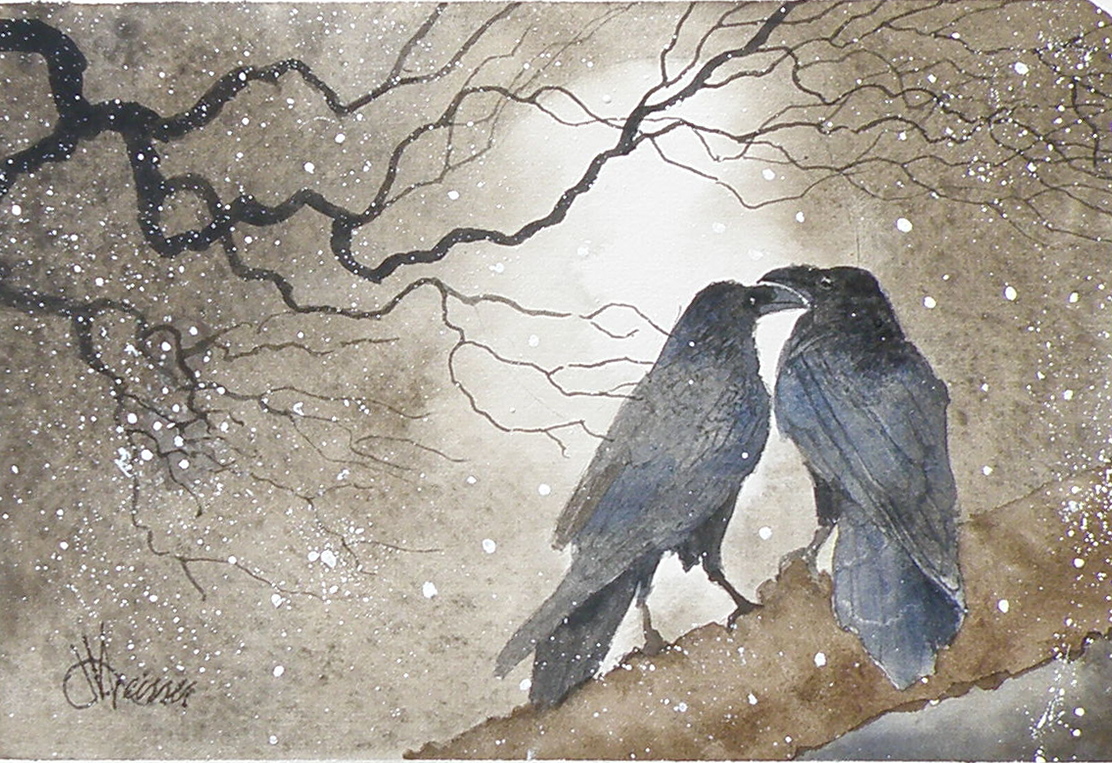
“Keeping Watch”
watercolour on Saunders Hot Press #140 lb paper, 4″ x 6″
I can’t quite explain why it is that depictions of Ravens sell so well, but they do. So it is a pleasure to be able to comply and feed the need, so to speak. They are indeed a very symbolic and ancient bird whose fame is heralded in many countries and cultural legends concerning them abound.
Out taking photographs of them this week, I came across a pair whose size was truly astonishing and whose throaty calls echoed off the nearby boulders and across the wide Thompson River. Once that is accomplished, it is a matter of trying to place them in a scene which has definite mood and emotional impact.
….draw a bird day
March 8, 2016
Teresa Robeson reminded me of ‘bird day’ (https://wordpress.com/read/feeds/4736591/posts/949345080#comments) with her striking rendition of an exotic Araripe Manakin from Brazil.
Here is a far more humble (don’t tell it that!) species, but at least I’m doing my birdy duty this Tuesday morning…..
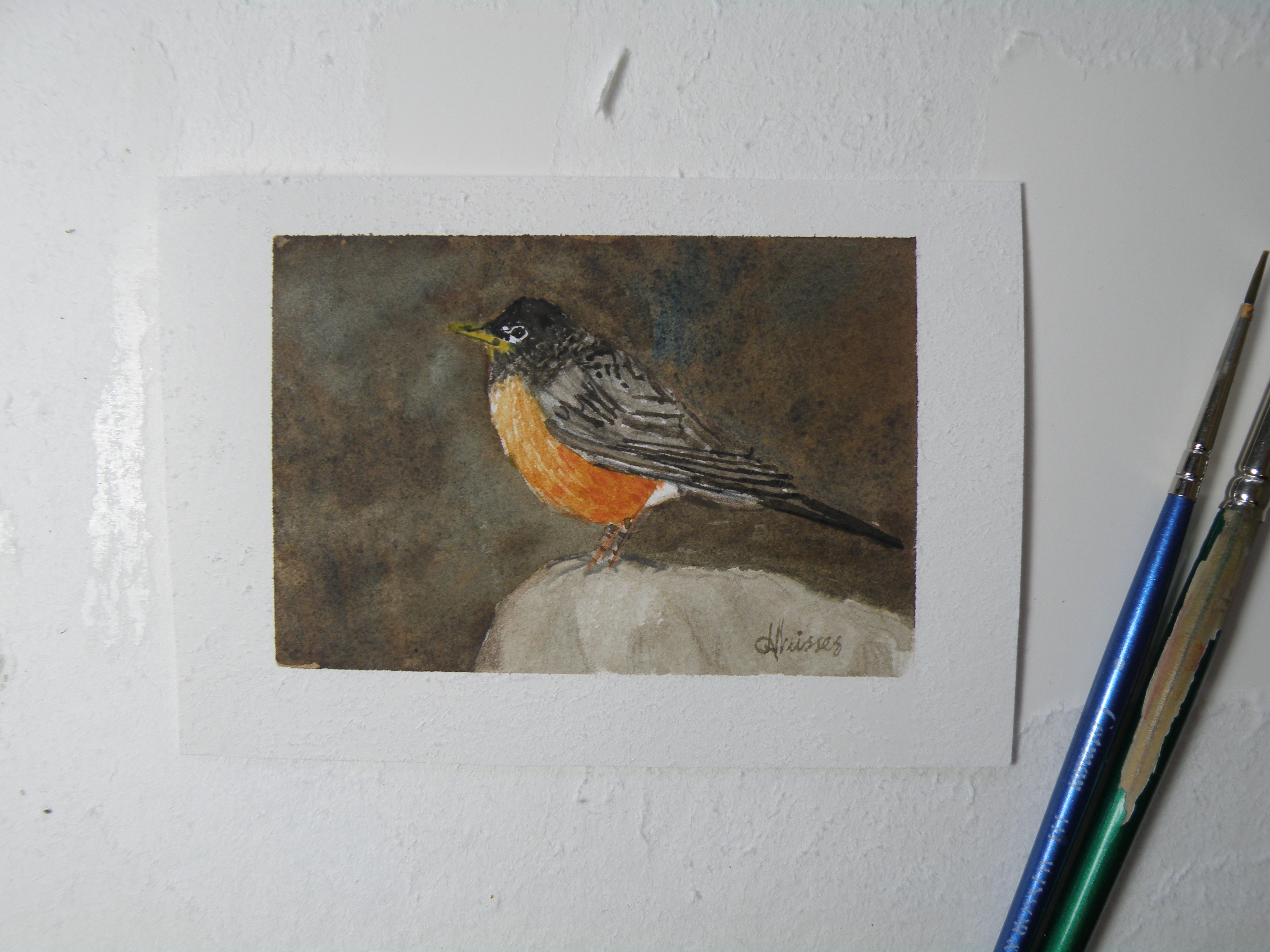
1.5″ x 2″ on Arches Hot Press 140# Paper
I saw my first one two weeks ago–around the third week of February–which is so early for this region, it is nuts. When they get here, they go for Mountain Ash berries and other withering, over-wintered types of fruit, until their usual fare of insects and worms become accessible. They are in breeding mode preoccupied with all their parental preparations.
…. Tranquille Creek Gorge
January 21, 2016
The watercolour video demonstrations of David Dunlop are challenging and yet simple. https://www.youtube.com/watch?v=Lgtg-Adql1Y&index=6&list=PLtEJwQmsB7SvVg8C4J2c4LDijerH7SSKF (I tried to embed the video itself in this post, but WordPress thought otherwise). But here is the blurb describing it….”Emmy Award winning David Dunlop takes you to his Connecticut studio to demonstrate a two minute watercolor, used as preparation for an oil sketch or to explore ideas“.
Mr. Dunlop is an artist/teacher from Connecticut, whose manner when teaching is inspiring and animated. He is a great follower of descriptive, energetic Masters like J.M.W. Turner and Winslow Homer, and seeks to employ their methods, while demonstrating their techniques.
The video cited above challenges painters to do two to three minute painting sketches, which convey the movement and mood and spirit of the subject, without stopping to think and rework. In an effort to ‘do’ and not think, the subject chosen here is a favourite–a place about 20 minutes from our house–called Tranquille Creek Gorge.
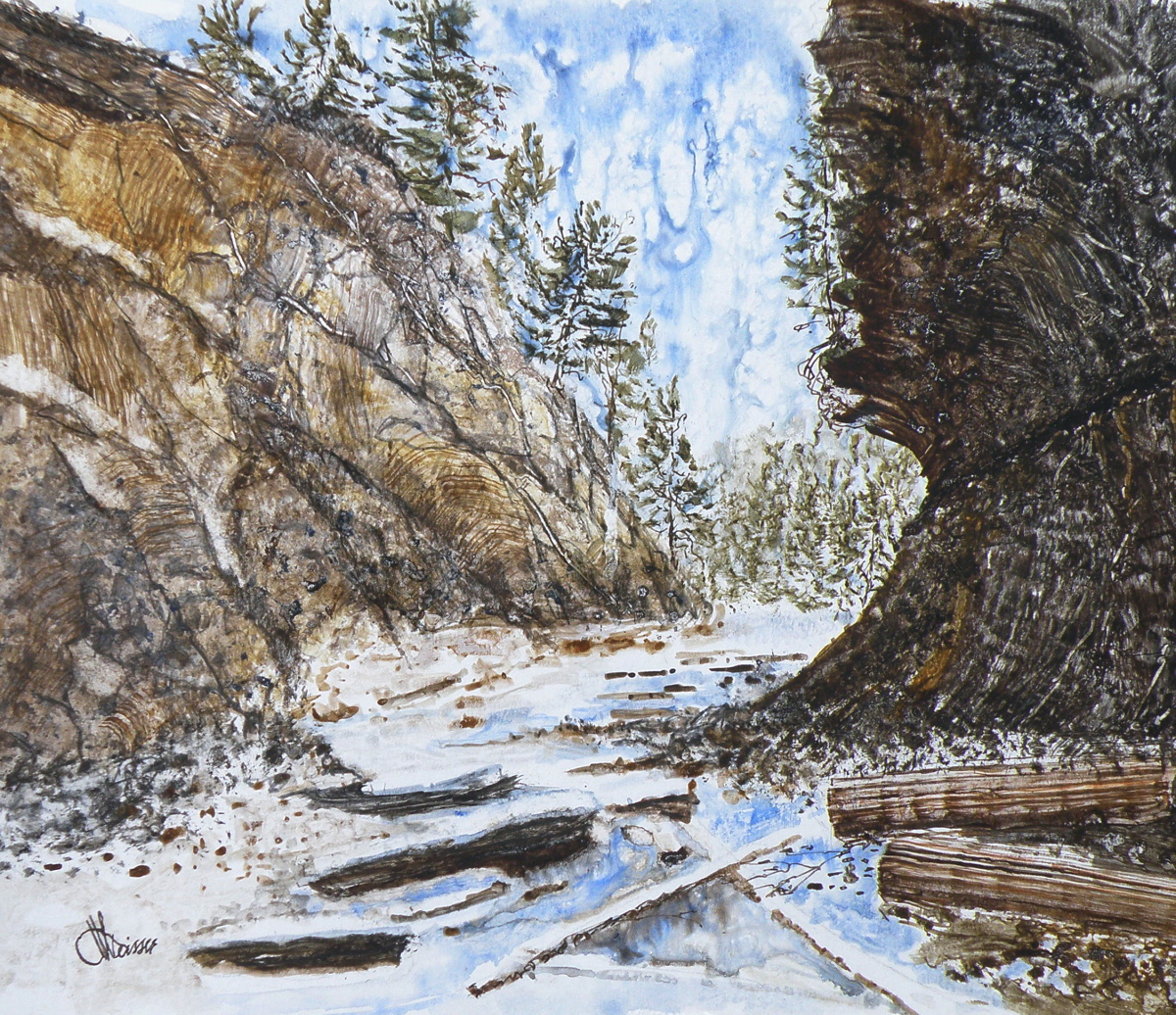
Mr. Dunlop’s videos are quite dynamic and aimed more at oil painters a bit more than watercolourists, but full of very encouraging lessons because of the force of his optimistic personality and sense of fun. They are well worth watching, for those who enjoy painting as a means of expression.
….composition exercise 2
January 17, 2016
Continuing on with an attempt to test out the compositional dictum known as ‘the rule of thirds’, which was conceived and named by John Thomas Smith in 1797 :
“. . . Analogous to this “Rule of thirds”, (if I may be allowed so to call it) I have presumed to think that, in connecting or in breaking the various lines of a picture, it would likewise be a good rule to do it, in general, by a similar scheme of proportion; for example, in a design of landscape, to determine the sky at about two-thirds ; or else at about one-third, so that the material objects might occupy the other two : Again, two thirds of one element, (as of water) to one third of another element (as of land); and then both together to make but one third of the picture, of which the two other thirds should go for the sky and aerial perspectives. . . “
To illustrate its basics…..
Once again, this is the drawing I did initially, to put this into practice….
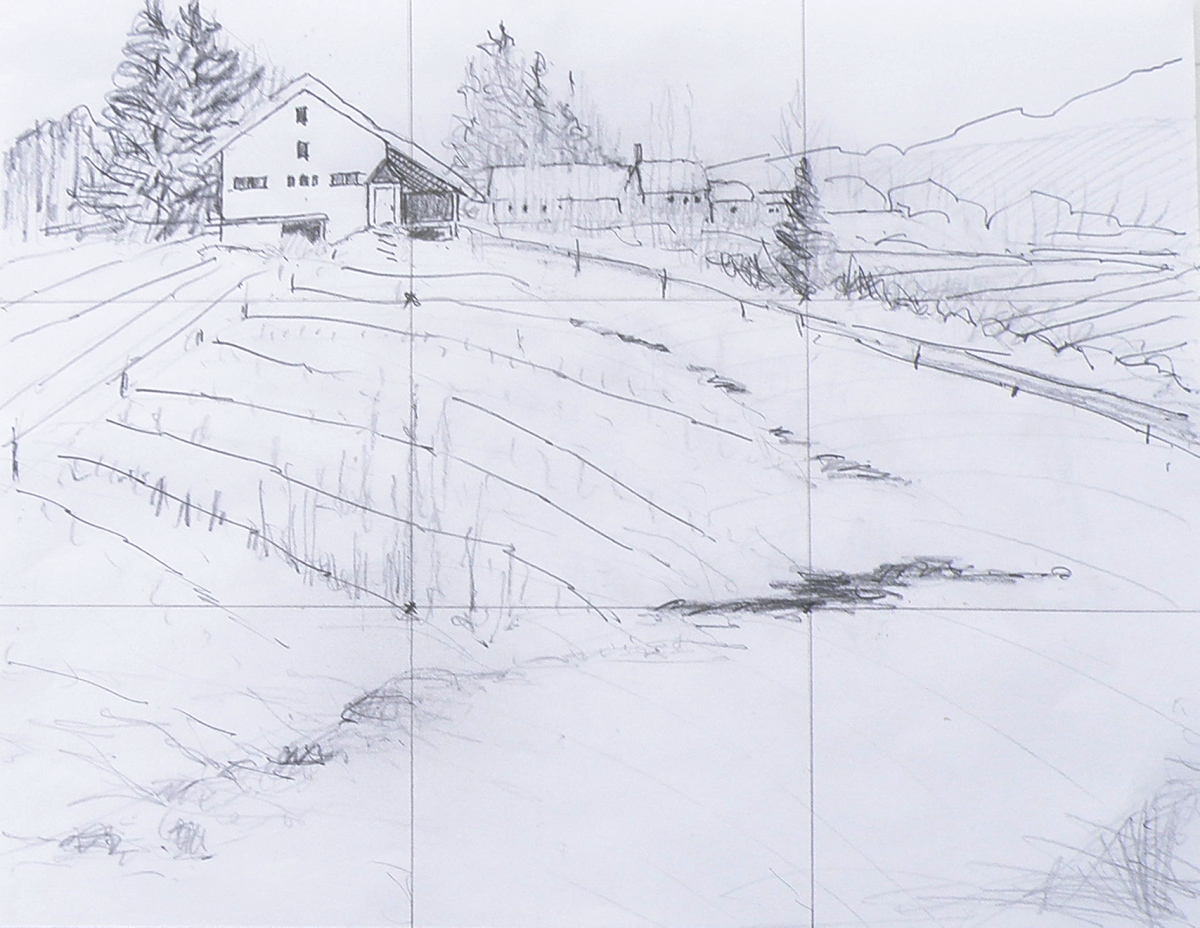
And this is the first go at painting the scene….
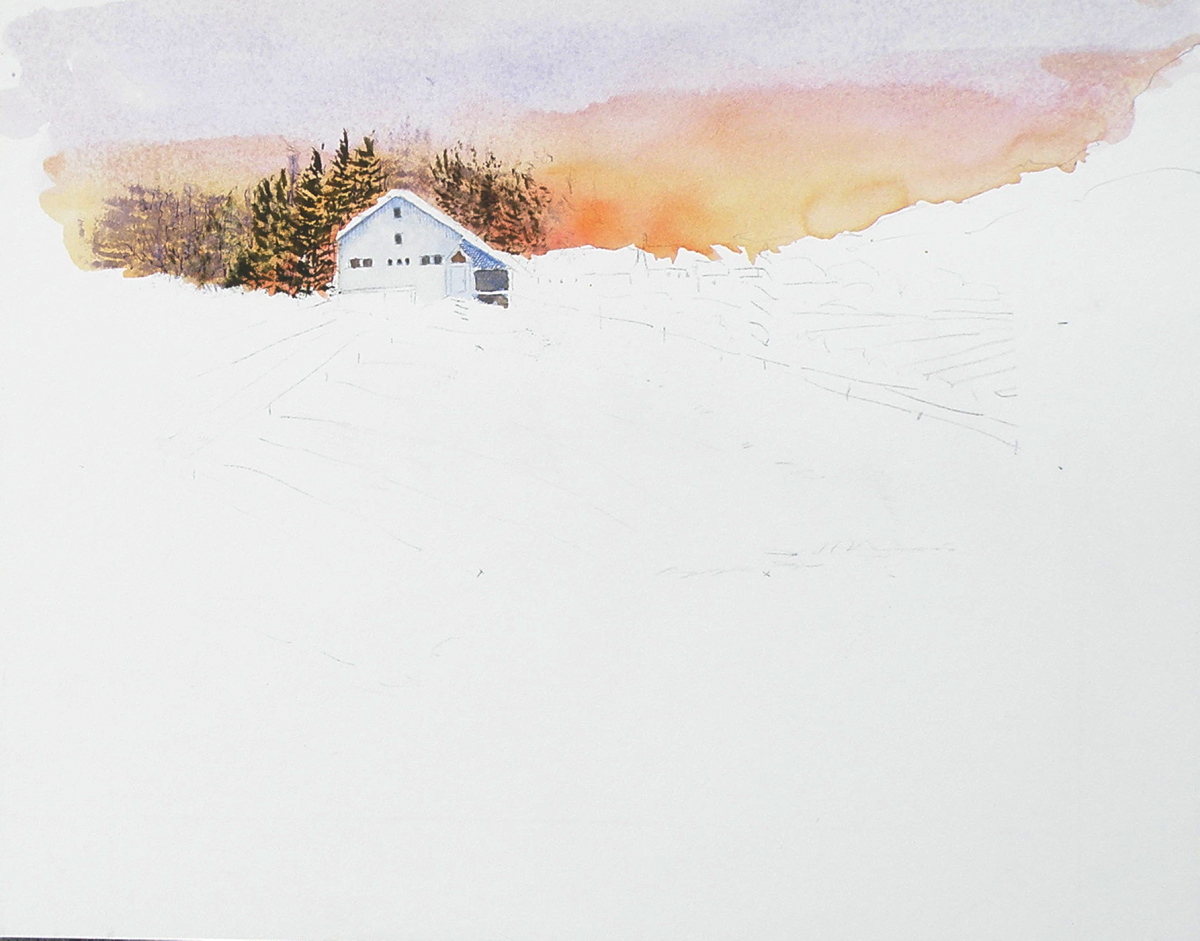
And now today, here is the progress so far, attempting to locate some visual interest at each of the four intersections within the piece, the barn being the first and the pine being the second and the creekbed being the third…..
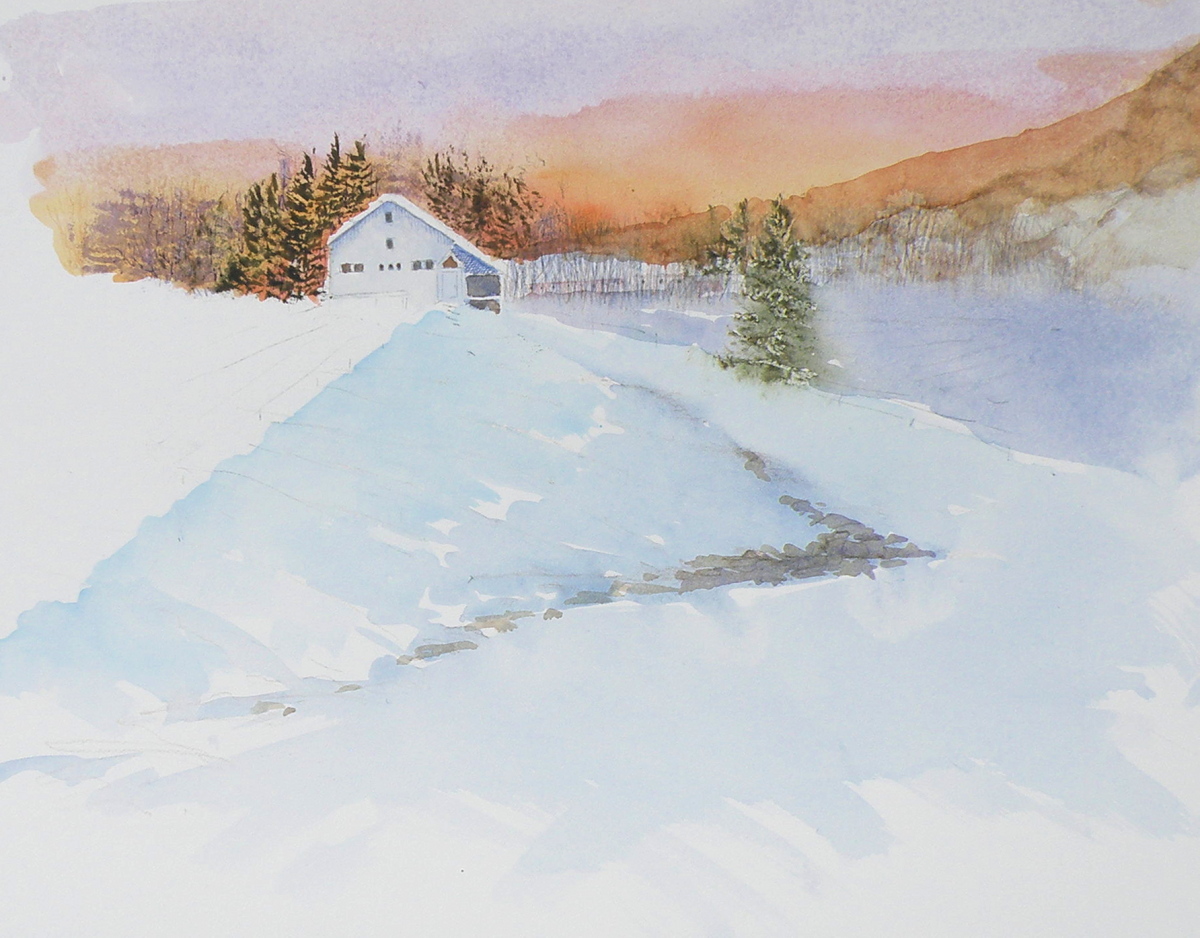
The darkest darks and greatest contrast will remain with the barn, for that is the intended focus for the picture, when completed.
The ‘rule of thirds’, as stated above, holds that generally two-thirds of a landscape be devoted to the sky, with one-third given to the land below (the sky being such a vast and dominant feature). In this case two-thirds is dedicated to the land and a very high horizon means that the one third is devoted to the sky area.
….snow
November 25, 2015
We received about 12cm overnight and now everything’s white, with temperatures starting to drop to around -10C (16F) under strong winds.
The birds are in the branches of the large Red Maple just beyond our big front window–at the four hanging feeders and suet cakes. We get mostly goldfinches and house finches, chickadees, juncos, nuthatches, flickers, clark’s nutcrackers, pine siskins, ring-necked doves, occasional pileated and downy woodpeckers, grosbeaks, stellar’s jays, magpies, ravens, white-crowned sparrows, and when it gets really cold the sweetly-blushing redpolls come down from the Arctic (but not likely until January or so).
Occasionally we see a Northern Pygmy Owl which swoops in on the dining lot, lighting on a branch like a handful of fluff with alarming eyes and causes the rest to take off like an explosion. They are one of a few daylight-hunting owls, and for two or three days following, the feeders remain untouched, the memory of that fist-sized, feathered-danger keeping everyone away.
In honour of the occasion — the advent of real Winter — a wintry watercolour, not unlike what the countryside looks like presently. The subject no doubt wishes the wind were less than it is….
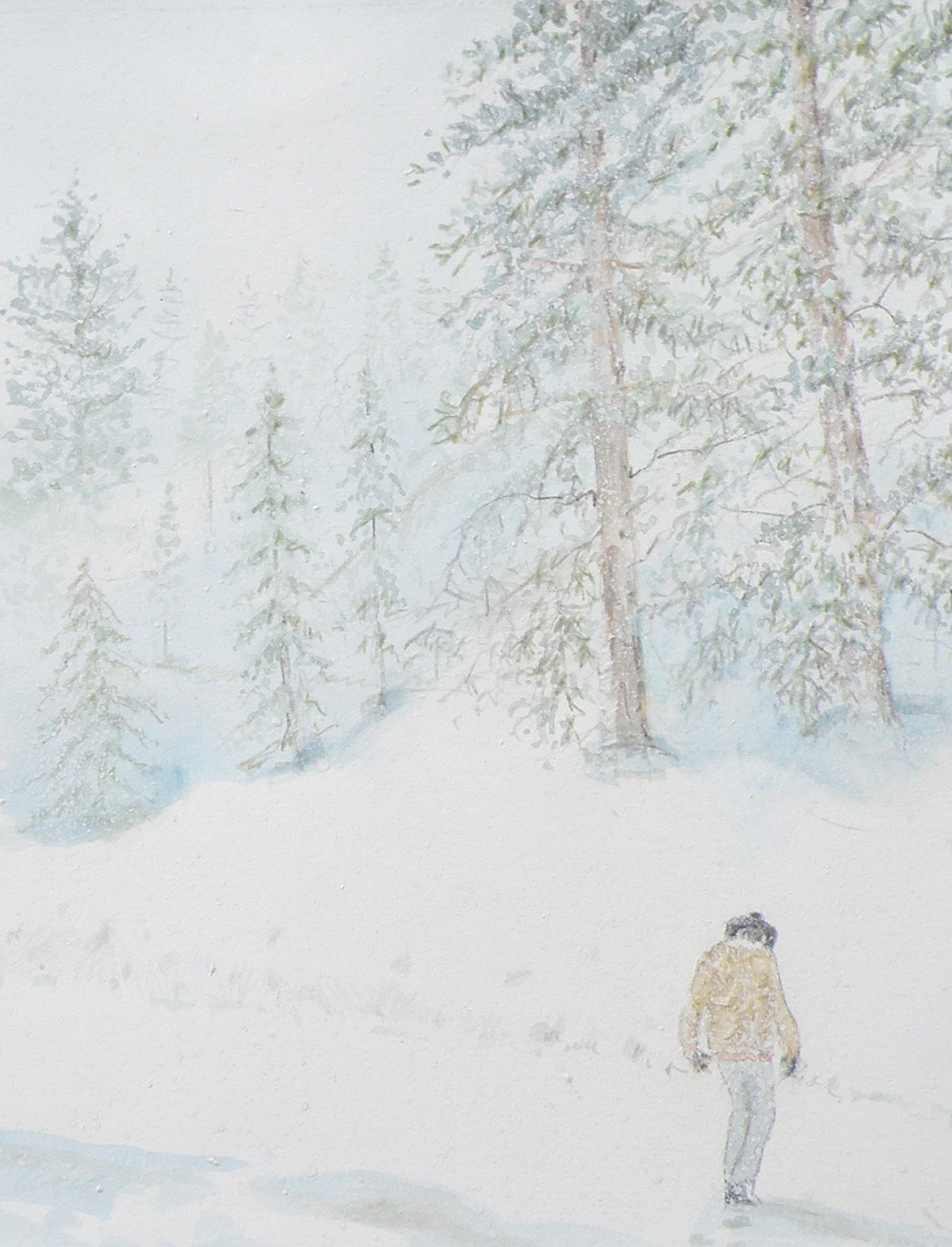
….but imagine the pleasures of fireplace and toddies once he gets back.
It’s an old painting–6 years–and approximately 8″ x 10″ on my favoured Arches Aquarelle Hot Press 140# paper. It took approximately 30 years to finally discover the right paper, having gone through all the choices of surface, weight, paper-maker (brand), and so on. Were it to be done again, the figure would be altered some, as there’s something anatomically odd about it.
….the silt bluffs
November 22, 2015
An area east of Kamloops, B. C., follows the South Thompson River which flows between dramatic limestone cliffs originally formed (it is estimated) 270 million years ago.
Among those cliffs is a gully–a waterworn ravine known as ‘the silt bluffs’, featuring very distinctive rock formations which have the look and feel of something out of a Western movie.
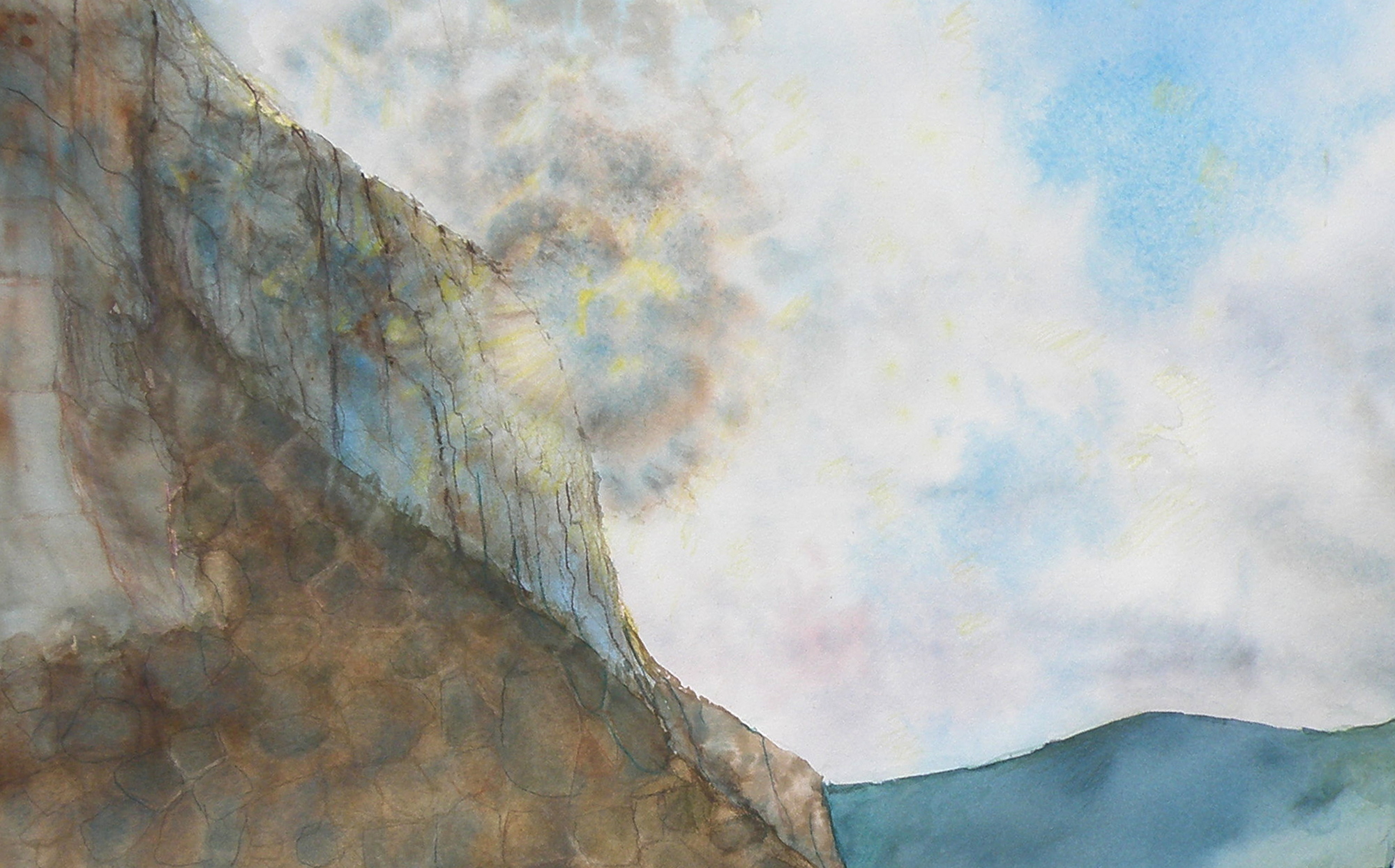
Massive geological formations such as these require some form of treatment by a painter in order to adequately convey their uniqueness and grandeur. This watercolour attempts to do that by purposely choosing to paint directly into the sun.
This part of our landscape gets quite literally baked by heat at midday, so when painting outdoors it is important to get it done quickly.
…..downtown, phase 2
November 9, 2015
The Plaza Hotel (completed in 1928) is a five story Spanish Colonial Revival building in downtown Kamloops BC, Canada. It is listed as a cultural heritage site in the Canadian Register of Historic Places.
As is so often the case when seeking out subjects for painting, the postcard view isn’t usually very interesting.
The photo used for reference for this watercolour was taken from the rear alley of The Plaza.
In view is the old Fire Hall tower, with belfry, 73 ft, built in 1935 at a cost of $24,500, when Kamloops had a population of approximately 6,000 (population today is about 100,000). It remains a distinctive landmark.
The decision to cast the subject in Winter has to do with wanting to bring some drama to the scene due to there being an overly abundant amount of sky. Pigeons have also been added to give more visual interest.
Because the hotel is a very light orange, (which gives off a bit of a pink cast in late afternoon), the sky is a wash of quin red, quin yellow and ultramarine blue in order to help incorporate the tones of the building into the rest of the painting. So quin red and quin yellow will be used as the shade of the hotel as the painting progresses.
hot
August 24, 2015
This has been one. hot. summer. Right now smoke from fires burning on the Washington State/Canada border is blowing up our way due to Southwest winds. It’s an acrid, doused campfire smell and hazy even when just looking across the street.
‘The Silt Bluffs, Kamloops’, watercolour on Hot Press #140 Arches, 19cm x 24cm, (7.5″ x 9.5″) sold
Oh yeah. I’m done. Bring me a nice serving of September.
heatwave relief
June 24, 2015
IT IS BARELY PAST the first day of Summer and temperatures here in Southern British Columbia, Canada, are scheduled to climb to 40C (104F) and stay there. It is feared the heat and drought affecting California is heading North, Along with such heat, thunderstorm probabilities rise, and they become fire starters. By August there’ll be what weather reports term ‘local smoke’–a haze hanging over everything–accompanied by the sound of helicopters and planes working to douse flames in affected regions close by.
My favourite month is November. It is both an exciting and contemplative month–exciting because any day, any moment I might step out to feel those fortifying winds suddenly becoming the first snow squall. Contemplative, because the fog rising from the closeby Thompson River mixes with wood stove breathings and the last of the leathery oak leaves falling to join the others, invites thoughts on things ethereal and eternal.
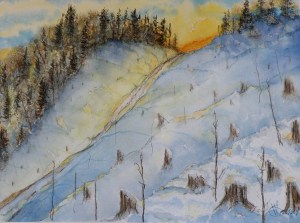
“Logging along Jamieson Creek Road”, watercolour, 20cm x 25cm, (8″ x 10″) Arches Hot Press 140 lb Paper, unsold
As a child, there was nothing more beautiful than what I called ‘purple snow’–that snow which signalled to us that we’d best take only one more turn sledding down Dead Man’s Hill (many years prior, legend had it, a man went down its twists and turns standing on his sled and smacked into a maple–back in the old days, when men apparently went sledding). Purple snow meant dinner. Purple snow meant finally discovering just how cold our digits actually were– thawing under a running cold faucet–pins and needles hot pink cold.
And even now, there is nothing to me more beautiful than purple snow. On this 40C second day of Summer, all I can say is, Lord get us through to November.
on display
June 22, 2015
THE OLD COURTHOUSE GALLERY CO-OP and Gift Shop got its start in 2007. The Courthouse itself is a Kamloops, B. C., landmark, built in 1909.
photo: Okanagan Art Review.com
A superb and intact example of the Edwardian Baroque style, its interior demonstrates an Arts and Crafts sensibility.
Mainly symmetrical, the building features an elaborate central entry, prominent parapet gables and a corner square-domed tower. It was constructed primarily of local brick, British Columbia stone such as granite, limestone and slate, and wood from local lumber mills. The choice of materials symbolized a commitment to the use of quality British Columbia products, a source of pride in this provincial building. An exceptional level of design and craftsmanship is evident throughout the building. It is one of the most accomplished designs of prominent architects Dalton & Eveleigh, and the stained glass came from the studio of Charles Bloomfield. (source: http://www.historicplaces.ca/en/rep-reg/place-lieu.aspx?id=12791)
Our Artists’ Co-op now consists of sixteen local artists, whose work is on display within one of the rooms of the original Courthouse. We are a group made up of several potters, glassmakers, jewelry makers, painters, two photographers, one dollmaker, and one weaver. I am currently the President.
Every month we schedule one or two of us to be the Featured Artists who occupy a special area just inside the entrance.
We are open five days a week, all year round, and our biggest event is called Christmas At The Courthouse where we invite and jury in arts and fine crafts vendors to sell their wares throughout the entire building . . .
mountain pine
June 20, 2015
In January 2011, a Pacific ponderosa pine in the Rogue River–Siskiyou National Forest in Oregon was measured with a laser to be 268.35 ft (81.79 m) high. This is now the tallest known pine. The previous tallest known pine was a sugar pine.
Ponderosa Pine photo by Jason Sturner
The needles are harvested by First Nations and other local artisans, then washed and woven into Ponderosa Pine needle baskets . . .
(photos: PineGardenBaskets, Etsy)
The mountain pine beetle is just over six millimetres long (about the size of a grain of rice). But the tiny forest insect has infested huge areas of mature pine around the interior of British Columbia, causing colossal amounts of damage on B.C. forests.
The beetle likes mature pine and mild weather. Because B.C. has more old pine than ever before, and has had several consecutive mild winters, mountain pine beetle populations have exploded to epidemic levels. (source + photo: Government of British Columbia)
Here in Kamloops, B. C., even pines growing in people’s yards get ravaged–as much as in our great forests. It is a helpless feeling, yet more and more innovative products are being developed from pine beetle timber.
Below is the Richmond, B. C., Olympic Skating Oval, totally made from pine beetle-killed timber. The wood has retained all the pine beetle bores and markings, and has been acclaimed as a ‘truly majestic work of art and design’.
photo: Architectural Review
tranquille creek gorge
June 3, 2015
ANCIENT FLOWS OF LAVA have left our regional landscape (Kamloops, B. C.) with dramatic canyons, a single lane dirt road skirting the edges.
MY PAINTING FRIEND MAX drove me through this arid landscape, only 10 minutes outside a city of nearly 100,000. Every so often she’d tell me of cars which had not been successful at executing a snowy, icy, tricky piece of road only to careen down the sides. At one place, the car was still there, making me both dizzy and almost nauseous, leaning over to see its rusting bulk caught between broken pines and rock.
‘MY GOD, WHERE WERE THEY HEADED?’ I’d asked. ‘Home, of course’, Max pointed ahead. And there was a small grouping of houses not far from the road, some fencing in horses or livestock–one had alpacas–and looking semi-deserted, though that was far from the case. Dogs barked at Max’s pickup as we threaded through and headed into yet more wilderness. ‘They take this road to Kamloops and back?’ — it seemed to my chicken, urban-minded guardedness a scary place to build one’s home. ‘Only for shopping, or a night on the town’, Max said. ‘Which is why someone sometimes doesn’t make it home–especially in the Winter.’
geology and art
May 31, 2015
ACCORDING TO GEOLOGIC FINDINGS, Kamloops, B. C., has limestone which dates back 270 million years. The earth itself is estimated to be some 4.5 billion years old. So the rock and sediment of Kamloops is relatively young in comparison, which is due to it having once been part of the ancient Pacific Ocean floor. Fossils in the area show ancient ocean plankton.
THE DOMINANT AND STRIKING, ANCIENT, WORN-DOWN MOUNTAINS within City Limits are the remains of ancient volcanic activity, and are remarkably bare of trees, gaining beauty from sunrises and sunsets, moonlight, and an annual ‘greening’, when the rains of Spring bring out the new leaves of Sagebrush and native grasses.
